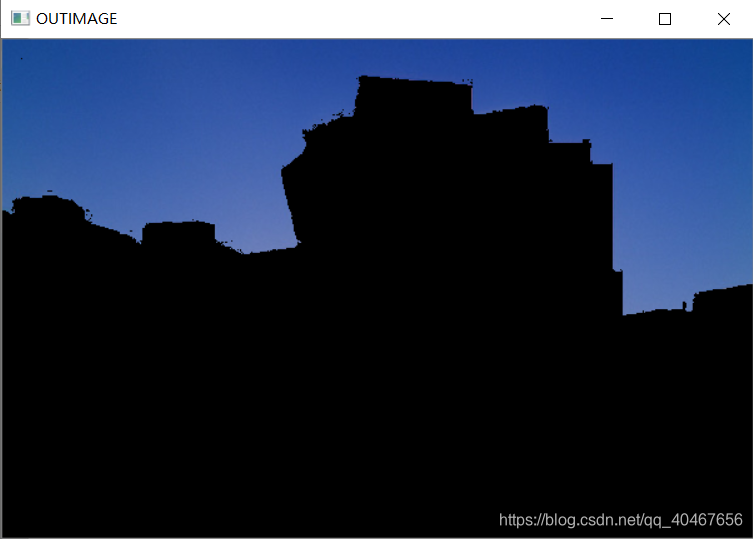OpenCV与图像处理学习十——区域生长算法(含代码)
- 一、区域生长算法概要
- 二、区域生长算法原理
- 三、代码应用
一、区域生长算法概要
区域生长是一种串行区域分割的图像分割方法。区域生长是指从某个像素出发,按照一定的准则,逐步加入邻近像素,当满足一定的条件时,区域生长终止。
区域生长的好坏决定于:
- 初始点(种子点)的选取。
- 生长准则。
- 终止条件。
区域生长是从某个或者某些像素点出发,最后得到整个区域,进而实现目标的提取。
二、区域生长算法原理
基本思想:将具有相似性质的像素集合起来构成区域。
步骤:
- 对图像顺序扫描,找到第1个还没有归属的像素, 设该像素为(x0, y0);
- 以(x0, y0)为中心, 考虑(x0, y0)的4邻域像素(x, y)如果(x0,y0)满足生长准则, 将(x, y)与(x0, y0)合并(在同一区域内), 同时将(x, y)压入堆栈(即满足条件,被判定为和(x0, y0)属于一个区域,后面需要再从这些点往外继续生长,所以需要保存);
- 从堆栈中取出一个像素, 把它当作(x0, y0)返回到步骤2(继续往外生长);
- 当堆栈为空时,返回到步骤1(有像素可能不属于前面的区域);
- 重复步骤1 - 4直到图像中的每个点都有归属时;生长结束。
三、代码应用
这里为简单起见,我们只设置了一个区域,即上述步骤中的第四步改为,当堆栈为空时,生长结束。
我们需要分割的图像如下所示:

我们将生长准则设置为像素值之间的欧式距离小于某个阈值,也就是说相邻像素值的差异较小时,归类为一个区域,代码如下所示:
# -*- coding:utf-8 -*-
import cv2
import numpy as np
###########################################################################################################################################################################
class Point(object):def __init__(self, x, y):self.x = xself.y = ydef getX(self):return self.xdef getY(self):return self.y
connects = [Point(-1, -1), Point(0, -1), Point(1, -1), Point(1, 0),Point(1, 1), Point(0, 1), Point(-1, 1), Point(-1, 0)]
#####################################################################################
# 计算两个点间的欧式距离
def get_dist(seed_location1, seed_location2):l1 = im[seed_location1.x, seed_location1.y]l2 = im[seed_location2.x, seed_location2.y]count = np.sqrt(np.sum(np.square(l1-l2)))return count# import Image
im = cv2.imread('./image/222.jpg')
cv2.imshow('src', im)
cv2.waitKey(0)
cv2.destroyAllWindows()
im_shape = im.shape
height = im_shape[0]
width = im_shape[1]print('the shape of image :', im_shape)# 标记,判断种子是否已经生长
img_mark = np.zeros([height, width])
cv2.imshow('img_mark', img_mark)
cv2.waitKey(0)
cv2.destroyAllWindows()# 建立空的图像数组,作为一类
img_re = im.copy()
for i in range(height):for j in range(width):img_re[i, j][0] = 0img_re[i, j][1] = 0img_re[i, j][2] = 0
cv2.imshow('img_re', img_re)
cv2.waitKey(0)
cv2.destroyAllWindows()
# 取一点作为种子点
seed_list = []
seed_list.append(Point(15, 15))
T = 7 # 阈值
class_k = 1 # 类别
# 生长一个类
while (len(seed_list) > 0):seed_tmp = seed_list[0]# 将以生长的点从一个类的种子点列表中删除seed_list.pop(0)img_mark[seed_tmp.x, seed_tmp.y] = class_k# 遍历8邻域for i in range(8):tmpX = seed_tmp.x + connects[i].xtmpY = seed_tmp.y + connects[i].yif (tmpX < 0 or tmpY < 0 or tmpX >= height or tmpY >= width):continuedist = get_dist(seed_tmp, Point(tmpX, tmpY))# 在种子集合中满足条件的点进行生长if (dist < T and img_mark[tmpX, tmpY] == 0):img_re[tmpX, tmpY][0] = im[tmpX, tmpY][0]img_re[tmpX, tmpY][1] = im[tmpX, tmpY][1]img_re[tmpX, tmpY][2] = im[tmpX, tmpY][2]img_mark[tmpX, tmpY] = class_kseed_list.append(Point(tmpX, tmpY))########################################################################################
# 输出图像
cv2.imshow('OUTIMAGE', img_re)
cv2.waitKey(0)
cv2.destroyAllWindows()
分割得到的结果如下所示:

很显然,天空的像素值较为接近,所以被生长为一片区域,而房屋的像素与天空的差异较大,当天空的区域生长结束之后,因为这里只设置了分割一块区域,所以下面的房屋部分没有遍历到。



)






)

 or a.all())



)


